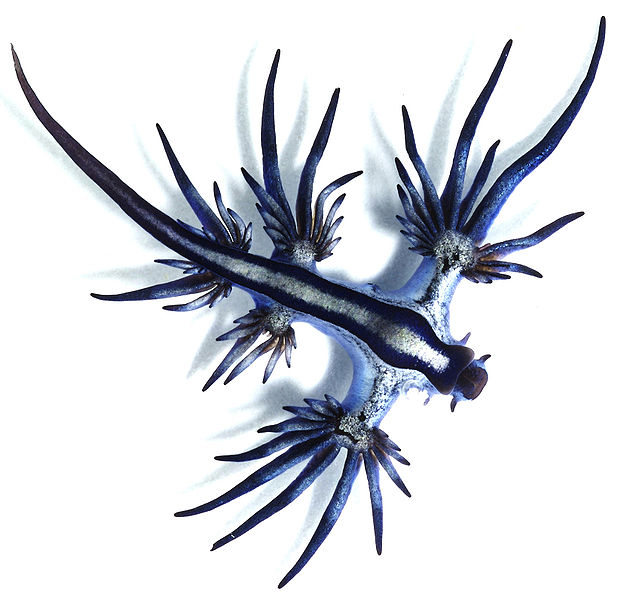Image: Creative Commons Taro Taylor/dapete
While it’s only a few centimeters long, this hallucinatory sea slug — Glaucus atlanticus — makes a living doing something few other organisms dare: snacking on the “Blue Fleet”, or collection of stinging, floating filter feeders found at the surface of oceans around the world. These wind-driven organisms (which will all be covered here at some point) include the by-the-wind sailor, blue buttons, the violet snail, and, most famously, Portuguese Men o’War, Physalia physalis.
The man o’ war floats on the surface like a plastic shipping cushion, dangling streamers of nematocyte-bearing and swimmer-irritating tentacles below (remember what those are?). G. atlanticus (also known quite poetically as the sea swallow) roams about the surface, trippy belly up and silvery top down, looking for its prey like pac-man pellets (though whether the sea swallow swims to its quarry or merely relies on bumping into it is still a point of contention among scientists). The sea slug, obviously, is immune to the stings and instead stores the venom at an even higher concentration at the tip of its feathery “cerata” (singular ceras), or body projections, for use in its own defense.
The sea swallow’s psychadellic cum mathematical coloration is allegedly a classic case of “countershading” camoflauge. From above, the blue and white confuses seabirds, while from below, the silvery top/bottom appears as just another section of sea.
Here’s an interestingly-scored home-video* of a day when someone walking along the beach found the wind had driven in scores of these little beauties, and who decided to cast as many back to sea as he could find to continue their vicious (but ecologically useful) bouts of predation. Gold star for the wise use of safety sand.
Sea slugs like the sea swallow are in the Heterobranchia within the gastropods (the snails and slugs), which are themselves nested in the molluks. You can explore this section of the tree of life here.
Kudos to my friend Molly for passing on a note alerting me to this little gem. Thanks Molly!
__________________________________________________________________________
*Look for the bonus blue button toward the end!



{ 1 trackback }
{ 5 comments… read them below or add one }
i noticed the blue button :)
hello, amazing
Thank you for yet another fine article, Jennifer.
I wrote up a short piece on my blog this morning with links to you, The Artful Amoeba and Glaucus atlanticus – trust this is okay with you.
Claire
Of course, Claire. Thank you!
Looks like one of those Cambrian-explosion-monsters. Aliens exist… and they are amongst us!
Watch and learn, James Cameron.
Wow, that’s one of the most beautiful creatures I’ve ever seen. Surreal. Thanks for that.